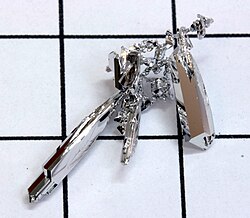Ruthenium
Ruthenium is a chemical element with symbol Ru and atomic number 44. It is a rare transition metal belonging to the platinum group of the periodic table. Like the other metals of the platinum group, ruthenium is inert to most chemicals. The Baltic German scientist Karl Ernst Claus discovered the element in 1844 and named it after Ruthenia, the Latin word for Rus'. Ruthenium usually occurs as a minor component of platinum ores and its annual production is only about 20 tonnes. Most ruthenium is used for wear-resistant electrical contacts and the production of thick-film resistors. A minor application of ruthenium is its use in some platinum alloys.
Occurrence
Ruthenium is exceedingly rare, only the 74th most abundant metal on Earth. This element is generally found in ores with the other platinum group metals in the Ural Mountains and in North and South America. Small but commercially important quantities are also found in pentlandite extracted from Sudbury, Ontario, Canada, and in pyroxenite deposits in South Africa. The native form of ruthenium is a very rare mineral (Ir replaces part of Ru in its structure).
| Symbol | Ru | |
| Atomic Number | 44 | |
| Atomic Weight | 101.07 | |
| Oxidation States | +3 | |
| Electronegativity, Pauling | 2.2 | |
| State at RT | Solid, Metal | |
| Melting Point, K | 2583 | |
| Boiling Point, K | 4173 |
Harmful effects:
Ruthenium is a suspected carcinogen and its compounds strongly stain the skin. Ruthenium tetroxide (RuO4) is highly toxic.
Characteristics:
- Ruthenium is a very rare, hard, lustrous, brittle, silvery-white metal that does not tarnish at room temperature.
- Typical of transition metals, ruthenium can exist in many oxidation states, its most common being the oxidation states II, III and IV.
- The metal is unaffected by air, water and acids.
- It reacts with molten alkali and halogens and can oxidize explosively.
Uses of Ruthenium
- Small amounts of ruthenium are used to harden platinum and palladium and it can also be alloyed with these metals to make electrical contacts for severe wear resistance.
- The addition of 0.1% ruthenium improves the corrosion resistance of titanium a hundred times over.
- Ruthenium has catalytic properties; for example, hydrogen sulfide can be split by light in the presence of an aqueous suspension of cadmium sulfide particles loaded with ruthenium dioxide.
- Interestingly, ruthenium is used in some Parker pen nibs, such as the Parker 51 whose nib is marked ‘RU’, and consists of 96.2% ruthenium and 3.8% iridium.
